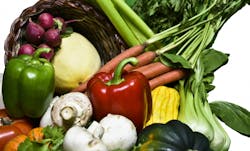Packaged Facts: 6 Fresh Foods From the Garden Shaping Culinary Trends
ROCKVILLE, Md., Sept. 21, 2016 /PRNewswire/ -- More than non-GMO, more than local, organic, or natural, more even than low price, consumers value freshness in food—and nothing says freshness like garden-fresh vegetables or fruit, according to market research publisher Packaged Facts in the brand new report, Garden and Grove: Culinary Trend Tracking Series (CuTTS). Packaged Facts consumer survey data from April 2016 show that freshness is the most important food characteristic to consumers across the board. This fandom for freshness extends to influential consumer segments such as Millennials, further securing the status of freshness at the center of culinary trends.
Packaged Facts' Culinary Trend Tracking Series (CuTTS) is the essential source for tracking culinary trends and opportunities in the restaurant, foodservice, retail prepared foods, and packaged food and beverage sectors. This latest edition Garden and Grove: CuTTS profiles six essential "garden and grove" food trends that are driving innovation in restaurants and retail: celery and fennel; fresh mint; radishes; specialty salad greens; shishito, Peppadew, and ghost peppers as emerging hot peppers; and cocktail bar fruit.
- Celery & Fennel - Celery and fennel each offer multiple opportunities in both restaurants and retail because of their versatility and the ability to use all parts of the plants in various ways. Use of fennel, in particular, is spreading rapidly in casual dining and fast casual restaurants. And both celery and fennel offer options for those looking for a brighter flavor and color during the winter months. Treating both vegetables as value-added products in grocery stores by displaying all the various parts together — bulb, root, stem, leaves, even seeds and pollen—draws and educates shoppers eager for new kitchen adventures.
- Fresh Mint - Mint can work miracles on menus. Beyond mint jelly with lamb chops, beyond tea and juleps and mojitos, fresh mint is enlivening appetizers, sandwiches, salads, relishes and salsas, and other savory dishes. Further, channeling the spirit of international cuisines is one of the best things spices and herbs like mint can do for food. With mint part of the arsenal of so many different on-trend cuisines—from Vietnamese to Mediterranean to Mexican—it's not surprising that chains are starting to pick up the trend, using mint as a kind of shorthand for authenticity.
- Radishes - Highly adaptable in the supermarket environment, the radish is a traditional salad bar item that can be sold as a value-added vegetable in the produce aisle, a burger topping at the deli counter, and as a roast chicken accompaniment on the hot food bar. Fast casual restaurants can take a cue from food trucks and juice bars by adding a peppery punch of radish to everything from fish tacos to breakfast smoothies.
- Specialty Greens - The world of specialty salad greens—including not only lettuces but also herbs such as sorrel and the many varieties of microgreens—is growing by leaps and bounds. Specialty salad greens add flavor, texture, color and value not only to salads, but also to small plates, as side-salad garnishes for appetizers and entrees, in sandwiches, and in other menu applications. Their availability is also growing at retail, particularly in the area of specialty mixes.
- Emerging Specialty Peppers - More consumers are seeking new and bold flavors in the form of hit heat-'em-up products like specialty peppers. And as consumer interest in ethnic foods and hot, spicy flavors continues to grow, lesser-known peppers are moving into the mainstream. Three of these newly "hot" hot pepper varieties are shishito, Peppadew, and ghost pepper or bhut jolokia. It's safe to assume that these peppers will continue to infiltrate mainstream menus and retailers, cropping up in more varied applications, such as soups, relishes and sauces, entrees, and side dishes.
- Cocktail Bar Fruit - All kinds of fruit are popular in cocktails, but consumers are increasingly interested in fresh, local ingredients, as well as internationally-inspired beverages. Focusing beverage menus on farm-to-glass offerings appeals to food-savvy customers (i.e., Millennials and Hispanics) and boosts premium alcohol sales. In addition, as spirits continue to grow in market share against beer and wine, cocktail culture is becoming more influential, providing new opportunities for fruit of all types to get in on the party, and also for non-alcoholic fresh beverages to follow and learn some tips from cocktails.
View additional information pertaining to Garden and Grove: Culinary Trend Tracking Series, including purchase options, the abstract, table of contents, and related reports at our website:http://www.packagedfacts.com/Garden-Grove-Culinary-10257048/.
